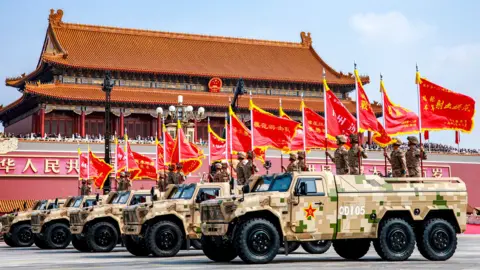The military might of the People's Republic of China was on full display in a parade marking the 80th anniversary of the end of World War Two on Wednesday.
Thousands of miles away, at the White House in Washington DC, Donald Trump was paying attention.
They were hoping I was watching, and I was watching, he said.
The American president didn't detail his thoughts about the massive celebration sprawled across Tiananmen Square, except that it was very, very impressive. The message from China – to Trump and to the world - however, seems fairly clear.
There is a new and growing centre of power in the world and a new alternative to the American-backed order of the past century.
Trump's remarks during a meeting in the Oval Office with Polish President Karol Nawrocki, also on Wednesday, shed little light on the matter. They were the culmination of a typically circuitous series of reflections by the American president on the happenings in China over the past several days. It was a mix of ambivalence, grievance and concern.
During a Tuesday podcast interview, Trump was nonchalant about the parade, saying he was not concerned about the Chinese show of force in front of Putin, North Korean leader Kim Jong Un and more than two dozen other heads of state.
By Tuesday night, however, he was grousing on his Truth Social website that China wasn't giving credit to the US for its support in World War Two.
Please give my warmest regards to Vladimir Putin and Kim Jong Un, as you conspire against the United States of America, he wrote.
Conspiracies aside, Trump has a soft spot for parades and demonstrations of military might. He welcomed Putin to Alaska last month with a stealth bomber flyover and a red carpet lined with US military jets. He has fond memories of attending France's Bastille Day celebrations during his first presidential term. And he hosted his own military parade to celebrate the US Army's 250th birthday in Washington two months ago.
Unlike Beijing's sleek display of high-tech armaments and precision marching masses, Trump's parade was a low-key homage to America's military history, as World War Two tanks and revolutionary-era soldiers walked casually down Constitution Avenue near the White House.
It was at its heart a nostalgic affair, befitting Trump's backwards-looking Make America Great Again slogan and his economic policy grounded in 19th-century mercantilism – a time when, Trump has often insisted, America was at its greatest.
Of course, China's parade – while dripping with futuristic weaponry - offered some historical narrative, as well – an attempt by the communist government to lay claim to a larger role in defeating fascism and imperialism in World War Two. If that conflict launched the so-called American century, Beijing may be hoping a newfound respect for its role could smooth the transition to a Chinese-crafted future.
Trump also has been ambivalent about conflicts and concerns far from US soil, instead focusing on a sphere of influence that includes a keen interest in America's immediate geographical neighborhood – Greenland, Panama, and Canada, among them.
The danger for Trump, however, is that his sweeping trade actions may end up being all risk and no reward. There are growing indications that the newly constructed America-centric trade regime could be dismantled in the days ahead by the US judiciary.
When it comes to trade, Trump has marched to his own beat – taking America on a dramatic new course and creating new international bedfellows in a matter of months. It’s an ambitious strategy that Trump has promised will lead to a second American golden age. But the dangers, whether on the parade grounds of Tiananmen Square or in US courtrooms, are very real.



















